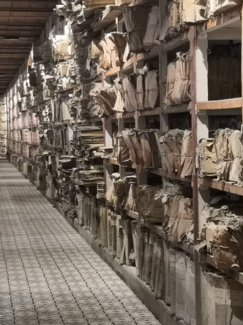The site Gancia
The State Archive subsidiary site is in the former convent of Santa Maria degli Angeli, also called “Gancia”. The convent belonged to the Friars Minor of the Observance, order founded by St Francis of Assisi.
The former convent of Santa Maria degli Angeli, also called La Gancia
In 1426, the friars established their own coenobium outside the city walls, in the contrada called S. Maria di Gesù, and wanted to acquire a place that could provide hospitality to religious people who went to town. During the 15th century they started the building of a great convent with the name of S. Maria degli Angeli, keeping the original epithet Gancia or Grangia.
The term “Grangia” meaning “farm belonging to monasteries” had been commonly given to lodgings depending on monasteries, convents and abbeys.
The oldest building of the convent dates back to the last twenty years of the 15th century. Some scholars claim that it was erected on the same area where probably stood the famous Muslim emirs’ palace. The church was built at the beginning of the 16th century and it is a wonderful architectural testimony of the Southern Renaissance. It holds several works of art such as paintings by Pietro Novelli, stuccos by Serpotta and sculptures by Gagini.
The expansion in the 17th century
Over the years, the convent expanded thanks to the construction of a big refectory that could host up to two hundred friars. In 1609, a new cloister was created “con giardino et altre delitie dentro” (with garden and other delights inside). The main gate of the convent, at the right of the church façade, is an expression of the architectural culture in Southern Italy during the Renaissance.
The well at the centre of the courtyard is in baroque style. More recent are the frescoes representing Virgin Mary and the friars, covering the remaining part of the old portico. At one corner of the courtyard there is a bronze bell that, according to the tradition, on April 4th 1860 was used to signal the start of the uprising led by Francesco Riso against the Bourbons.

The former friars’ refectory was rented in 1615 to the Tertiaries who later decorated it with stuccoes and frescoes and dug a burial pit still visible. The frescoes represent episodes from the Gospel, the all-round stuccoes on the walls and the vault are of religious inspiration mixed with floral and sea themes, in a style close to that of Serpotta who worked in the church of the Gancia since 1680.
From convent to Archives
As early as 1854 the Bourbon government determined that the vast building should be used as Archives. Indeed, in 1859 the records of the ancient notaries were transferred there to the premises formerly designated as a charity hospice by the Bourbon government. Later, the newborn Italian State acquired the entire building to designate it as subsidiary site of the State Archives.
Bibliography
[2024 ed. FG, tr. EC]
Ultima modifica: 26 Febbraio 2024
